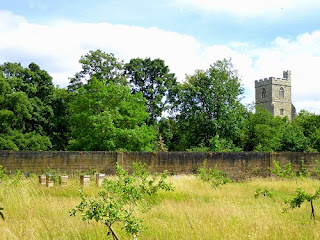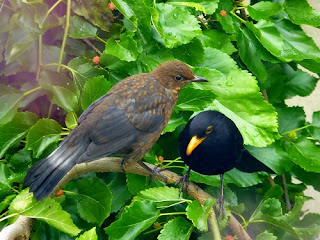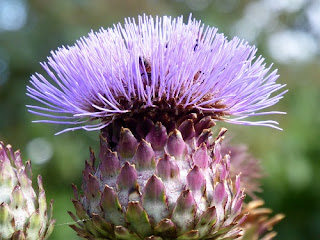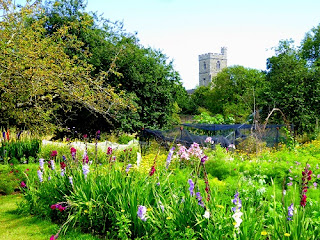Fulham Palace's splendid grounds, encased by Bishop's Park, themselves enfold a treasure of reconstruction, the walled garden dating from the mid-18th century and incorporating a Tudor wall with gateway. The whole enclosure was shut down not long after Kew Gardens during quarantine, and reopened a while after Kew. I went there at the first opportunity, on 3 July. First sight once past the main gate - hollyhocks near the Tudor facade of the palace,
and then the gingko just to the right of the Tudor gateway, with the tower of All Saints' Fulham visible beyond the south wall.
I've already written extensively on rediscovering this paradise years after it had fallen into rack and ruin, with photos to match, but no harm in an update. It's always been free of charge, but now volunteers sit near the gateway collecting £2 donations. I joined the Friends on the spot, since the place has given me so much delight already (and I did volunteer to garden an afternoon a week, but they already have more folk than they need). The project, splendidly overseen by head gardener Lucy Hart, is evolving; last week I saw for the first time her work on bringing back some of the plants from the Americas which Bishop Compton had introduced, before his successor dug them up in favour of produce (as she shows, it's now possible to have both). Lovely as the fringe of dahlias following the wall certainly was, the turning of the north-east wall, or at least half of it, into a proper herbaceous border is very welcome,
and who doesn't love a giant echium?
The bees from the nearby hives
certainly do, and quite a few peacock butterflies were landing on Verbena bonariensis
or settling on the wall (at this small size, you can just make one out to the right of the hollyhock).
The time of the 100-year-old-plus wisteria's main blossoming was past, but it was still putting out a few flowers.
We're now heading to a time of mellow fruitfulness, and pears were already promising.
Still, on that first visit the keenly-anticipated cart with produce from the vegetable gardens was not on display. It has been more recently, and I'll end with the second of four visits. Meanwhile, other favourite haunts of the lockdown time occasionally yielded what Fulham Palace did not. Delphiniums, for example, in Regent's Park, where we met our friend Isabel in the Rose Garden for afternoon tea two days later.
The grand formality of the walks on the eastern side of the parks was at ite best, too.
I walked my bike this way in search of a repair shop on or just off Great Portland Street. The options I'd hoped for were closed, but - oh, wonder - an Evans store provided the solution, very unexpectedly at 4.30pm on a Sunday afternoon. All very well ordered, too, a sign of reassurance that if our government couldn't organise anything, individual stores could, and have.
Order was eventually restored in a strange spectacle below the beautiful bridge of Chiswick House Gardens. In a previous post, I charted the moorhen's motherhood saga. Looking down on the nest, I was perplexed to see a mallard with her two chicks on the next. So what was that behind her?
Turned out to be a growing moorhen child. Five minutes later, there was a divebombing, almighty birdshrieks, and the duck was off with her fledglings to the safety of the bank. So the usurpation was very short-lived.
Bird life in the back yard was at this time centred on the weeping mulberry and its abundant fruits. The blackbird family had disappeared for a while, and of course has now gone off to moult somewhere, but I was alerted by some very peculiar squawking, and saw Junior in the transitional phase from speckled brown to black (tailfeathers first). He's larger than dad. I just missed the moment where dad popped a mulberry into his big boy's maw.
Hadn't had sight nor sound of the dunnock for some time either, until I saw a group of four. This is presumably alpha male aloft the blackberry.
Ring-necked parakeets are now everywhere along the Thames - as well as in neighbouring squares but not our own central gardens - but I've not seen them doing the lovebirds act until I cycled back to Battersea Park on 28 July.
I had three ports of call, including the Children's Zoo, where you can see ring-tailed lemur activity from outside the gate,
and the garden run by Thrive, the therapeutic charity, excellent for tips on bee-friendly plants. Eryngia are perfect, offsetting with their startling blue the yellow both of other flowers in the general colour-scheme
and of the insects which love them. Can anyone identify this one?
There's another good eryngia display in Holland Park, in those endlessly well-tended and changed beds around the pond where a heron loves to preen on the central fountain.
Here's one (heron) in flight near Hammersmith Bridge.
The third resource within Battersea Park has only just reopened - the English Garden with its perfect waterlilies
and artichoke flowers, another delight for bees.
A clump is the remaining glory of the rose garden in front of Chiswick House's camellia conservatory.
And so back on 30 July, via Fulham Palace, looking good after work on its brick facade,
to the Walled Garden, where on a blazing sunny day fruit and vegetable sales were in full swing. Such swift changes even in a couple of weeks.
The herbaceous border was flourishing still more
and gladioli were in full swing around the borders of the vegetable beds.
Dame Edna's favourites make a fine addition to the bunches of flowers on sale, or did for the short time of their flourishing. Here's a display with other trophies - a range of tomatoes from the glass houses, each variety with its own distinct flavour, beans and beetroots.







































4 comments:
How lovely it all looks! I've never seen hollyhocks of such a rich purple. Here, it's been too hot to go to Innisfree, which is our only garden within reasonable distance, so we content ourselves with wildflowers blooming in the fields where we walk before the heat. So, all the more welcome to see so much in bloom in the gardens you visited. PS: Been meaning to note to you, as we haven't managed Glyndebourne on our past visits to England, a friend here alerted me to its online "open house" offerings. Have so far watched The Rake's Progress, Giulio Cesare, and, most recently, The Fairy Queen. All thoroughly enjoyable.
Yes, they've been serving up some of the best (including Richard Jones's production of Der Rosenkavalier, but you can get that and most of the others on DVD). They've also been serving up garden concerts, but these are all sold out and critics not invited, so I've missed out. Ah, heat, I remember, on our cold and wet Bank Holiday (meaningless under present circumstances anyway) Weekend.
what beautiful photos from a fasinating place ..
It is quiet at the edge of London .I went there once a lunch with the late DD and the Late TT
The bus went through some quiet ordinary parts of London. To me,in my innocence/ignorance Fulhlam equated with Gamaour and affluence.
do you have strong views on the rule britannia situation
It can also be quiet in the very centre of London - in any of the parks. Fulham is frankly a bit dull, yummy mummy territory, but the riverside is full of interest.
I loathe the storm in a teacup reactionaries brewed up over the Last Night. The solution is simple and elegant - they play both works in their original Proms versions, 'Land of Hope and Glory' as the trio tune of Pomp and Circumstance - Elgar hated the words that were subsequently added - and 'Rule, Britannia!' as the last number in Henry Wood's original 'Fantasia on British Sea Songs' (it was Malcolm Sargent who reorchestrated it so a soloist could sing the words). I hate it that Dalia Stasevska and her family received death threats, which seems to be the natural consequence of national delusion these days.
Post a Comment